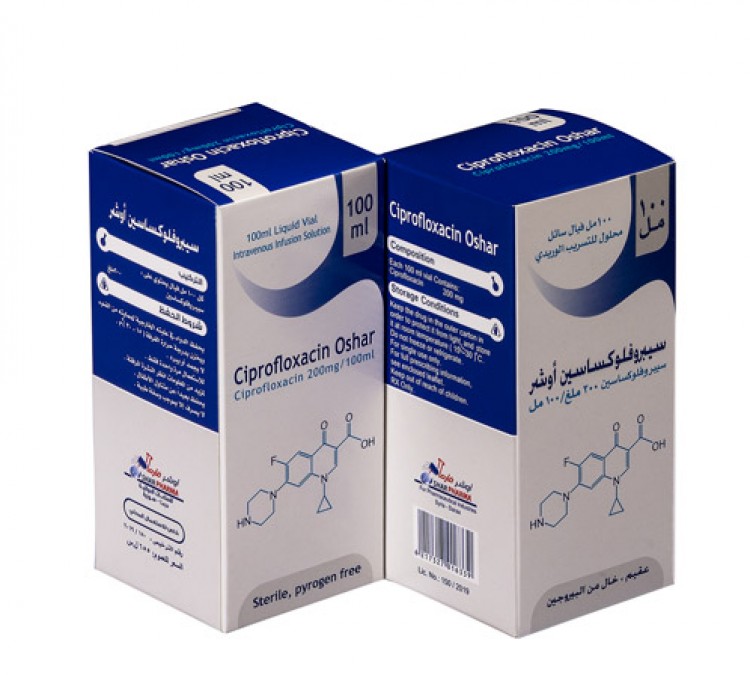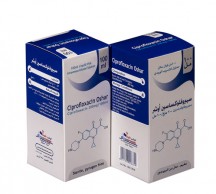Ciprofloxacin Oshar
Lower respiratory tract infections,Chronic suppurative otitis media,Acute exacerbation of chronic sinusitis, Urinary tract infections, Genital tract infections, Infections of the gastro-intestinal tract , Intra-abdominal infections, Infections of the skin and soft tissue , Malignant external otitis, Infections of the bones and joints
Composition
Each 100 ml vial contains 200 mg ciprofloxacin .
excipient: lactic acid , sodium chloride , hydrochloric acid , water for injection .
Usage
Indications:
Ciprofloxacin solution for infusion is indicated for the treatment of the following infections:
Adults
- Lower respiratory tract infections due to Gram-negative bacteria :
- exacerbations of chronic obstructive pulmonary disease
- broncho-pulmonary infections in cystic fibrosis or in bronchiectasis
- pneumonia
- Chronic suppurative otitis media
- Acute exacerbation of chronic sinusitis especially if these are caused by Gram-negative bacteria
- Urinary tract infections
- Genital tract infections
- epididymo-orchitis including cases due to susceptible Neisseria gonorrhoeae
- pelvic inflammatory disease including cases due to susceptible Neisseria gonorrhoeae
- Infections of the gastro-intestinal tract (e.g. travellers` diarrhea)
- Intra-abdominal infections
- Infections of the skin and soft tissue caused by Gram-negative bacteria
- Malignant external otitis
- Infections of the bones and joints
- Inhalation anthrax (post-exposure prophylaxis and curative treatment) (Drug administration should begin as soon as possible after suspected or confirmed exposure).
- Ciprofloxacin may be used in the management of neutropenic patients with fever that is suspected to be due to a bacterial infection.
Children and adolescents:
- Broncho-pulmonary infections in cystic fibrosis caused by Pseudomonas aeruginosa
- Complicated urinary tract infections and pyelonephritis
- Inhalation anthrax (post-exposure prophylaxis and curative treatment) (Drug administration should begin as soon as possible after suspected or confirmed exposure).
- Ciprofloxacin may also be used to treat severe infections in children and adolescents when this is considered to be necessary. Treatment should be initiated only by physicians who are experienced in the treatment of cystic fibrosis and/or severe infections in children and adolescents.
Contraindications:
- Hypersensitivity to the active substance, to other quinolones or to any of the excipients.
- Concomitant administration of ciprofloxacin with tizanidine.
Side Effects
- Common: injection and infusion site reactions (only intravenous administration), Nausea , Diarrhea
- Uncommon: Mycotic superinfections, Eosinophilia, Decreased appetite, Psychomotor hyperactivity, agitation, Headache, Dizziness, Sleep disorders, Taste disorders, Vomiting, Gastrointestinal and abdominal pains, Dyspepsia, Flatulence, Increase in transaminases, Increased bilirubin, Rash, Pruritus, Urticaria, Musculoskeletal pain (e.g. extremity pain, back pain, chest pain), Arthralgia, Renal Impairment, Asthenia, Fever, Increase in blood alkaline phosphatase.
- The following undesirable effects have a higher frequency in the patients that receiving intravenous or (intravenous to oral) treatment:
- Common: Vomiting, Transient increase in transaminases, Rash
- Uncommon: Thrombocytopenia, Thrombocytaemia, Confusion and disorientation, Hallucinations, Par-and dysaesthesia, Seizures, Vertigo, Visual disturbances, Hearing loss, Tachycardia, Vasodilatation, Hypotension, Transient hepatic impairment, Cholestatic icterus, Renal failure, Oedema.
| Properties |
Mechanism of action:
The bactericidal action of ciprofloxacin results from the inhibition of both type II topoisomerase (DNA-gyrase) and topoisomerase IV, required for bacterial DNA replication, transcription, repair and recombination.
Pharmacokinetic:
Following an intravenous infusion of ciprofloxacin the mean maximum serum concentrations were achieved at the end of infusion,Ciprofloxacin is largely excreted unchanged both renally and, to a smaller extent, faecally.
|
||||||||||||||||||||||||||||||||||||||||||||||||||||||||||||||||||||||||||||||||||||||||||||||
|---|---|---|---|---|---|---|---|---|---|---|---|---|---|---|---|---|---|---|---|---|---|---|---|---|---|---|---|---|---|---|---|---|---|---|---|---|---|---|---|---|---|---|---|---|---|---|---|---|---|---|---|---|---|---|---|---|---|---|---|---|---|---|---|---|---|---|---|---|---|---|---|---|---|---|---|---|---|---|---|---|---|---|---|---|---|---|---|---|---|---|---|---|---|---|---|
| Dosage | Dosage and administrations: After intravenous initiation of treatment, the treatment can be switched to oral treatment with tablets or suspension if clinically indicated by the physician. IV treatment should be followed by oral route as soon as possible.Treatment of infections due to certain bacteria (e.g. Pseudomonas aeruginosa, Acinetobacteror Staphylococci) may require higher ciprofloxacin doses and co-administration with other appropriate antibacterial agents. Treatment of some infections (e.g. pelvic inflammatory disease, intra-abdominal infections, infections in neutropenic patients and infections of bones and joints) may require co-administration with other appropriate antibacterial agents depending on the pathogens involved.
Paediatricpopulation:
Dosing in children with impaired renal and/or hepatic function has not been studied. Elderly patients: Elderly patients should receive a dose selected according to the severity of the infection and the patient`s creatinine clearance. Patients with renal impairment: Recommended starting and maintenance doses for patients with impaired renal function:
Patients with hepaticimpairment: In patients with impaired liver function no dose adjustment is required. Method of administration Ciprofloxacin solution for infusion should be checked visually prior to use. It must not be used if cloudy. Ciprofloxacin should be administered by intravenous infusion. For children, the infusion duration is 60 minutes. In adult patients, infusion time is 60 minutes for 400 mg Ciprofloxacin solution for infusion and 30 minutes for 200 mg Ciprofloxacin solution for infusion. Slow infusion into a large vein will minimize patient discomfort and reduce the risk of venous irritation. The infusion solution can be infused either directly or in parallel with other compatible infusion solutions. Overdose: Symptoms in overdose consist of dizziness, tremor, headache, tiredness, seizures, hallucinations, confusion, abdominal discomfort, renal and hepatic impairment as well as crystalluria and haematuria. Reversible renal toxicity has been reported. In the event of overdose, symptomatic treatment should be implemented. ECG monitoring should be undertaken, because of the possibility of QT interval prolongation
|
||||||||||||||||||||||||||||||||||||||||||||||||||||||||||||||||||||||||||||||||||||||||||||||
| Drug interactions | Drug Interaction: Drugs known to prolong QT interval: Ciprofloxacin, like other fluoroquinolones, should be used with caution in patients receiving drugs known to prolong QT interval (e.g. Class IA and III anti-arrhythmics, tricyclic antidepressants, macrolides, antipsychotics) Probenecid: Probenecid interferes with renal secretion of ciprofloxacin. The co-administration increases ciprofloxacin serum concentrations. Methotrexate: Renal tubular transport of methotrexate may be inhibited by concomitant administration of ciprofloxacin, potentially leading to increased plasma levels of methotrexate and increased risk of methotrexate-associated toxic reactions. The concomitant use is not recommended Theophylline: Concurrent administration of ciprofloxacin and theophylline can cause an undesirable increase in serum theophylline concentration, serum theophylline concentrations should be checked and the theophylline dose reduced as necessary Other xanthine derivatives: On concurrent administration of ciprofloxacin and caffeine or pentoxifylline (oxpentifylline), raised serum concentrations of these xanthine derivatives were reported. Phenytoin: The coadministration may result in increased or reduced serum levels of phenytoin such that monitoring of drug levels is recommended. Ciclosporin: A transient rise in the concentration of serum creatinine was observed when ciprofloxacin and ciclosporin were administered simultaneously. Therefore, it is frequently (twice a week) necessary to control the serum creatinine concentrations in these patients. Vitamin K antagonists: Simultaneous administration of ciprofloxacin with a vitamin K antagonist may augment its anti-coagulant effects. The INR should be monitored frequently during and shortly after co-administration of ciprofloxacin with a vitamin K antagonist (e.g., warfarin, acenocoumarol, phenprocoumon, or fluindione). Lidocaine: possible interaction with ciprofloxacin associated with side effects may occur upon concomitant administration. Sildenafil: caution should be used when ciprofloxacin used concomitantly with sildenafil taking into consideration the risks and the benefits. Cytochrome P450 Ciprofloxacin inhibits CYP1A2 which may cause increased serum concentration of concomitantly administered substances metabolised by this enzyme (e.g. theophylline, clozapine,olanzapineropinirole, tizanidine, duloxetine). Co-administration of ciprofloxacin and tizanidine is contra-indicated. Therefore, patients taking these substances concomitantly with ciprofloxacin should be monitored closely for clinical signs of overdose, and determination of serum concentrations (e.g. of theophylline) may be necessary Ropinirole: Monitoring of ropinirole-related side effects and dose adjustment as appropriate is recommended during and shortly after co-administration with ciprofloxacin. Clozapine: Clinical surveillance and appropriate adjustment of clozapine dosage during and shortly after co administration with ciprofloxacin are advised Incompatibilities with other solutions: Unless compatibility with other solutions/drugs has been confirmed, the infusion solution must always be administered separately. Ciprofloxacin infusion has been shown to be compatible solution for infusion ( Ringer's solution, Sodium chloride (0.9%), Glucose (5%) and (10%) and Fructose (10%) ) when infused in parallel When ciprofloxacin infusion solutions are mixed with compatible infusion solutions, for microbial reasons and light sensitivity these solutions must be administered shortly after admixture
|
||||||||||||||||||||||||||||||||||||||||||||||||||||||||||||||||||||||||||||||||||||||||||||||
| precautions and precautions | Warnings and precautions:
|
||||||||||||||||||||||||||||||||||||||||||||||||||||||||||||||||||||||||||||||||||||||||||||||
| Package | Storage conditions: keep the drug in the outer carton in order to protect from light , and store it at room temperature (15 º C – 30 º C ) How supplied: a carton box contains 100 ml vial
|
||||||||||||||||||||||||||||||||||||||||||||||||||||||||||||||||||||||||||||||||||||||||||||||


